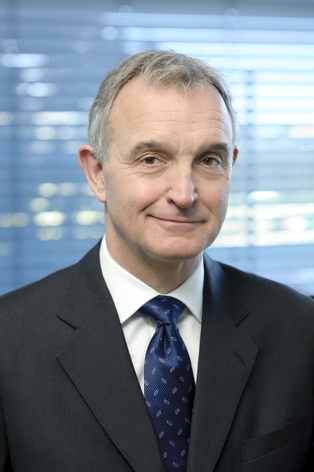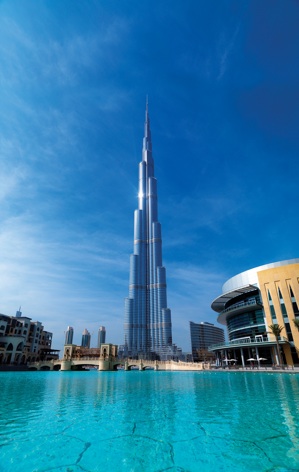
Lindsay Harvey
President, UK, Central and Eastern Europe (UCEA)
Harvey joined Otis as an apprentice, and completed a mechanical engineering degree as part of his apprenticeship. During his time with the company he has worked in sales, sales management, product development, product management, and run the company’s new equipment and sales management operations. Prior to taking on the UCEA role, he was director of the company’s operations in Australasia and China, based in Shanghai.
We’re in a golden age of skyscrapers. Not since the 1920s — the era of the Empire State and Chrysler Buildings — have so many tall towers been built, although their homeland has shifted Eastward, from the megacities of the US to the oil-funded futuristic fantasias of the Middle East and the burgeoning metropolises of East Asia.
The defining technology of the skyscraper is the lift; without a mechanised means to moving people up the building, these towers would be completely impractical. One of the pioneers of lift technology, Otis, is still at the forefront, over 160 years after its foundation.
‘We’re looking at a rapid expansion of high-rise building,’ explained Leslie Harvey, president of the UK, Eastern and Central Europe business at Otis, who until recently was head of its Chinese operations. ‘In the next three years, we’ll see the number of skyscrapers over 400m — the height of the old World Trade Center in New York — around the world double, and all of the new ones will be in Asia or the Middle East.’
By 2018, there will be 33 buildings of 400m or higher under construction, he added. ‘And in China alone, we’re expecting there to be 3000 buildings we’d classify as high-rise.’
Planners, architects and structural engineers are becoming ever more ambitious, Harvey noted, as can be seen from the last three holders of the world’s tallest building record. The Petronas Towers in Kuala Lumpur are 452m high; Taipei 101 in Taiwan is 509m, and the current record holder, Burj Khalifa in Dubai, is 828m. Now on the drawing board is the Kingdom Tower, planned for Jeddah in Saudi Arabia, whose height has yet to be finalised, but is said to be in the 1000-1200m range.
“In the next three years, we’ll see the number of skyscrapers over 400m double.

‘The challenges in high-rise, especially when you approach a kilometre in height, are considerable,’ he said. ‘And the first one is obviously safety.’ This was at the heart of the company’s foundation, he pointed out — company founder Henry Otis built his business on the invention of an elevator safety brake. ‘It’s still one of our key absolutes,’ he said, ‘and it’s increasingly important in very tall buildings, not just with respect to the travelling public, but also for the service personnel and the installing and construction teams: it’s the key priority for us in designing and managing a high rise project.’
The other main priority in the design process is what Harvey terms the handling capacity — the way the lift systems work in getting the building’s population into and out of their floors. ‘This is the driver for the size of the elevators and the speed they move,’ he explained. It also determines the way the lift systems are controlled, and is the main driver behind new product development.
The number of people that need to be taken in the lift system of course diminishes the further up the building you go, and relatively few lift cars — typically only one or two — go all the way to the top of even the highest buildings. There is a limit to how much the lift system can be sectionalised, however, because the more sections there are, the more lift shafts have to be accomodated in the building. This would mean that the core of the building would become extremely large towards the lower floors, which would compromise the design. ‘It just wouldn’t work in architectural terms,’ Harvey said.
To get around this, designers are increasingly opting for a different way to increase the carrying capacity of the lifts: multi-storey lift cars. ‘We use double decker lifts to increase the capacity, and now we’re moving to triple-deck lifts in designs for some of the taller buildings in the conceptual stage, such as Kingdom Tower,’ Harvey explained. In these systems, lift cars are literally mounted one on top of the other and are accessed by double- or even triple-height lift lobbies on the building’s ground floor. When the lifts ascend, they stop on two floors simultaneously (so in a double lift, the lower car serves odd floors and the upper car evens).
This, of course, means that the lift control system has to be somewhat more complex than the familiar push-buttons by the door. ‘We use a destination system called Compass, which works with identity cards,’ Harvey explained. ‘Your ID card holds the information about which floor you need to get to, and you present your car at a speed gate which then assigns you a lift that’s going to your floor. If you want to go to a different floor, you use a touch-screen by the gate to indicate that, and your assignment is made accordingly. It’s more like a bus service, really.’
The access system dictates the architecture and design of the ground floor, with escalators needed to take people to the right mezzanine level for their lift raising the possibility of an MC Escher-like look for the lobby level of Kingdom Tower.
Designing lifts is very much a fight against gravity, and like many engineering sectors, reducing the weight of the systems is uppermost in Otis’s R&D activities. ‘When you get to extreme heights above 400m, the weight of the ropes themselves — not just the ropes that actually lift the cars, but also the compensation ropes that stop the car from bouncing around — becomes more of an issue,’ Harvey said. ‘Reducing the weight is important for a couple of reasons — it helps us build higher, and it helps us keep the energy requirements for running the systems down.’
“Reducing weight helps us build higher and keeps the energy requirement down
Recent innovations include replacing cylindrical ropes with flat belts made from steel and polypropylene for the lifts in the lower section of the building. This has two advantages, Harvey explained: it reduces overall weight, and because the belts bend more easily than ropes, it reduces the size of the pulleys needed to operate the system. ‘There’s a minimum diameter that a rope can bend through — it tends to be four time the diameter of the rope itself,’ Harvey explained. ‘With the belt system, you can get the pulley wheel size down to 100-120mm, whereas with a rope, you’d be looking at 600-700mm. That’s a significant material and weight saving, and it changes the whole dynamic of the system — it helps increase the speed you can move the lifts.’
Ropes are still needed for the lifts which travel higher in the building, and for these Otis is looking at alternative materials, such as combining carbon fibre with steel cores.

Latest lift systems use a regenerative drive, with the lift cars descending under gravity and transforming the lifting motor into a generator. ‘We can clean that energy up and put it straight back into the power grid,’ Havey said. ‘These systems are well understood, and they save 75 per cent of the power of a conventional system.’
Overall, the drive is to make lifts smaller, faster and lower energy, while still maximising the number of people they can carry and without compromising the architects’ and civil engineers’ vision for the building. ‘There’s obviously going to be a limit to the height of the building, which will be related to the materials and the ability to service the height of the building,’ Harvey said. ‘And one of the things we’re looking at, in terms of the building codes, is being able to use the lifts in a lifeboat mode so that people can use them during an emergency, which currently isn’t allowed. You’d have to make sure that there’s no way you can release people into a hazardous zone, such as a floor that’s on fire. It’s going to be a difficult problem to crack, but we’re working on it.’




Nanogenerator consumes CO2 to generate electricity
Whoopee, they've solved how to keep a light on but not a lot else.